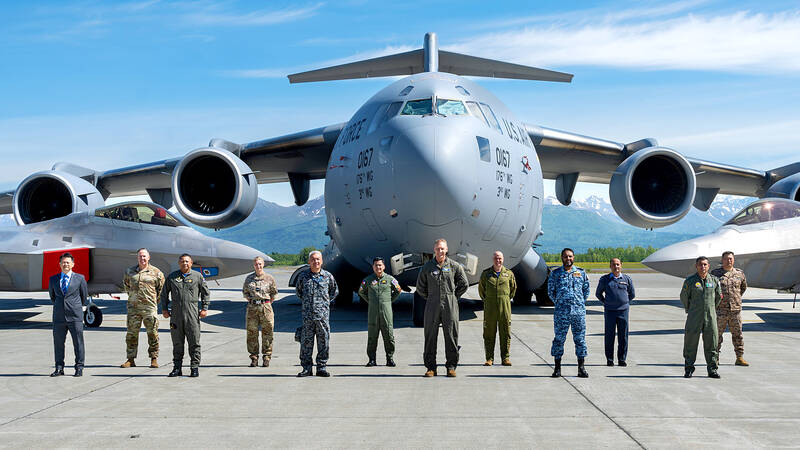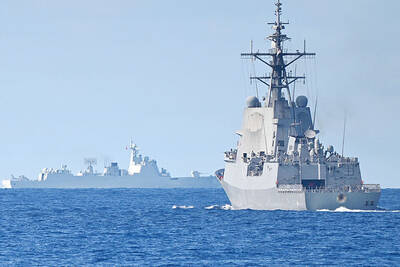Senior Taiwanese military personnel observed a US-led joint air exercise alongside the South Korean and Japanese air forces in Alaska, a now-removed image published on Tuesday by the Pentagon showed.
The caption of the image — which has since been removed from the US military’s Defense Visual Information Distribution Service — said that senior-ranking military observers from Taiwan, Japan, the Philippines, Malaysia, Thailand, Bangladesh, the UK and Canada on Friday last week gathered at Joint Base Elmendorf-Richardson to observe the Red Flag-Alaska 25-2 exercise.
The exercise involved an estimated 1,500 personnel and 70 aircraft from the US, Japanese and South Korean air forces, the US Indo-Pacific Command (INDOPACOM) said in a news release.

Photo courtesy of the US Department of Defense
The drills aimed to strengthen multinational integration in support of the US Pacific Air Forces’ strategic objective of “credible, combat-ready forces capable of projecting power and deterring aggression in the region,” it said.
The exercise’s participants conducted offensive and defensive aerial operations in mock battles under “contested, degraded and operationally limited environments,” it said.
INDOPACOM emphasized the US strategic partnership with Japan and South Korea, saying that the exercise would “sharpen warfighting skills and enhance interoperability in support of a free and open Indo-Pacific.”
“Red Flag Alaska 25-2 allows US military forces and our Pacific-based allies to safely train for a high-end fight, ensuring a lethal force prepared for deterrence,” said US Air Force Major Michael Dzyndra, the Red Flag-Alaska deployed forces deputy commander.
“We’re not just training together; we’re learning how to integrate more effectively to meet shared challenges head-on,” the release quoted him as saying.
“Red Flag-Alaska offers the Japan Air Self Defense Force a valuable opportunity to enhance interoperability intensively with the United States Air Force and other air forces of allied nations, while also deepening mutual understanding,” Japan Air Self Defense Force Air Support Commander Colonel Kazuhiro Nakajima said in the release.
The joint combat scenarios build the operational capability of participating units with the training occurring across the Joint Pacific-Alaska Range Complex, the Pacific Air Forces said.
The air drills build operational capability by training forces across the Joint Pacific-Alaska Range Complex, INDOPACOM said.

RESPONSE: The transit sends a message that China’s alignment with other countries would not deter the West from defending freedom of navigation, an academic said Canadian frigate the Ville de Quebec and Australian guided-missile destroyer the Brisbane transited the Taiwan Strait yesterday morning, the first time the two nations have conducted a joint freedom of navigation operation. The Canadian and Australian militaries did not immediately respond to requests for comment. The Ministry of National Defense declined to confirm the passage, saying only that Taiwan’s armed forces had deployed surveillance and reconnaissance assets, along with warships and combat aircraft, to safeguard security across the Strait. The two vessels were observed transiting northward along the eastern side of the Taiwan Strait’s median line, with Japan being their most likely destination,

‘NOT ALONE’: A Taiwan Strait war would disrupt global trade routes, and could spark a worldwide crisis, so a powerful US presence is needed as a deterrence, a US senator said US Senator Deb Fischer on Thursday urged her colleagues in the US Congress to deepen Washington’s cooperation with Taiwan and other Indo-Pacific partners to contain the global security threat from China. Fischer and other lawmakers recently returned from an official trip to the Indo-Pacific region, where they toured US military bases in Hawaii and Guam, and visited leaders, including President William Lai (賴清德). The trip underscored the reality that the world is undergoing turmoil, and maintaining a free and open Indo-Pacific region is crucial to the security interests of the US and its partners, she said. Her visit to Taiwan demonstrated ways the

GLOBAL ISSUE: If China annexes Taiwan, ‘it will not stop its expansion there, as it only becomes stronger and has more force to expand further,’ the president said China’s military and diplomatic expansion is not a sole issue for Taiwan, but one that risks world peace, President William Lai (賴清德) said yesterday, adding that Taiwan would stand with the alliance of democratic countries to preserve peace through deterrence. Lai made the remark in an exclusive interview with the Chinese-language Liberty Times (sister paper of the Taipei Times). “China is strategically pushing forward to change the international order,” Lai said, adding that China established the Asia Infrastructure Investment Bank, launched the Belt and Road Initiative, and pushed for yuan internationalization, because it wants to replace the democratic rules-based international

RELEASED: Ko emerged from a courthouse before about 700 supporters, describing his year in custody as a period of ‘suffering’ and vowed to ‘not surrender’ Former Taiwan People’s Party (TPP) chairman Ko Wen-je (柯文哲) was released on NT$70 million (US$2.29 million) bail yesterday, bringing an end to his year-long incommunicado detention as he awaits trial on corruption charges. Under the conditions set by the Taipei District Court on Friday, Ko must remain at a registered address, wear a GPS-enabled ankle monitor and is prohibited from leaving the country. He is also barred from contacting codefendants or witnesses. After Ko’s wife, Peggy Chen (陳佩琪), posted bail, Ko was transported from the Taipei Detention Center to the Taipei District Court at 12:20pm, where he was fitted with the tracking